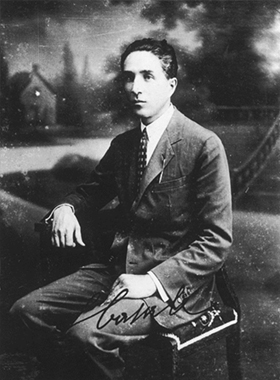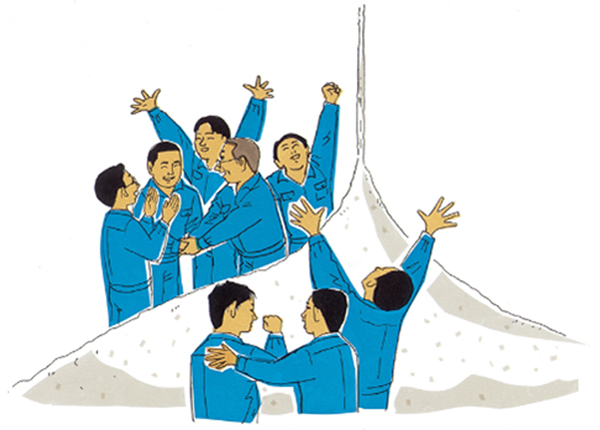At the Minamata plant, Noguchi devoted himself to his research to the point of forgetting to eat and sleep, continuing his efforts day and night without rest to improve quality. He would jump out of bed if a good idea came to mind in the middle of the night and would hurry to the plant still in his pajamas. As a result, the quality of the calcium carbide improved, and the electric heating furnaces for calcium cyanamide, said to be the most difficult part in the production process, were also improved. Operations went smoothly and years of hard work finally paid off.
Construction the Kagami Plant
After successfully producing calcium cyanamide, in Kumamoto Prefecture Noguchi built the 7,000kW Shirakawa power plant and Kagami plant for ammonium sulfate. The ammonium sulfate was produced from calcium cyanamide in a continuous process.
 The Kagami plant at the time of construction
The Kagami plant at the time of construction
In May 1914, Noguchi and the other employees were working through the night. In the wee hours, they were finally able to produce one ton of pure white ammonium sulfate, as white as snow, and cheers erupted all round.
This was a remarkable achievement. They had created ammonium sulfate through the process of fixing atmospheric nitrogen, and it caused a great sensation in the chemical industry in Japan.
From that point, the demand for ammonium sulfate in Japan gradually began to grow. Up until then, Japan relied mostly on expensive imported products, but Noguchi now made ammonium sulfate at.Nippon Cisso Hiryo K.K.’s Kagami plant, the first to have its own power generation.
Sales of ammonium sulfate from the Kagami plant grew and it became profitable. In roughly ten years since its founding, Nippon Cisso Hiryo K.K. had taken a firm step forward. During that time, business conditions in Japan had improved due to the First World War, and the price of ammonium sulfate rose. Noguchi successively expanded his business through his enthusiasm and efforts as an entrepreneur. It seemed like the blink of an eye.
In 1918, Noguchi came down with pneumonia and at one point became seriously ill and was at risk of dying, but fortunately he made a full recovery. While he regained his health, the confusion in the global economy following the First World War had a great effect even in Japan, and the world entered another recession with stock prices crashing. This was destined to have an effect on Noguchi’s business. Cheap, foreign-made ammonium sulfate was imported in large quantities, and the demand for domestically-produced ammonium sulfate fell. The patent for calcium cyanamide was also about the expire.
In 1921, Noguchi went to Europe to search for new technology. He discovered the Casale ammonia synthesis process that produced fertilizer using water and air.
Patent Licensed for the Casale Ammonia Synthesis Process
While traveling in Europe, Noguchi was fortunate to encounter Dr. Luigi Casale, an Italian chemist. He also succeeded in licensing the patent for the Casale ammonia process which had been invented by Casale himself.
The encounter with Casale was a happy coincidence that can only be described as an unexpected bounty. It was a great joy for Noguchi to be able to take a tour of a plant in Terni, Italy. This small plant was using Casale’s ammonia synthesis process. Noguchi was fascinated by the odor of ammonia at the plant. He thought, “This could become profitable.”
He immediately entered into negotiations with Casale to license the patent. Monetary value had fallen in Italy at the time due to inflation, and Casale said he would give over the rights for ten million lire (currently one billion yen). Noguchi proceeded with the negotiations, thinking he couldn’t miss this opportunity by spending too much time acquiring a license to the patent.
 Luigi Casale
Luigi Casale
However, even though he had set his mind on licensing the patent, he was given a two week postponement because the negotiations required the enormous sum of ten million lire and he couldn’t make this decision on his own. He traveled to Bern, Switzerland, and contacted Nippon Cisso Hiryo K.K.’s headquarters in Osaka from there.
His decision was quick, and once he received the company’s approval, he returned to Rome, paid a 100 million yen deposit, signed a provisional agreement, and returned to Japan. In December 1921, he went back to Italy and signed an agreement with Casale for the rights to the process and for the purchase of all necessary machinery.
This determination and courage to invest large amounts of money into licensing patents was due to Noguchi’s clear foresight. Obtaining a license to this patent would steady his business in the future.


